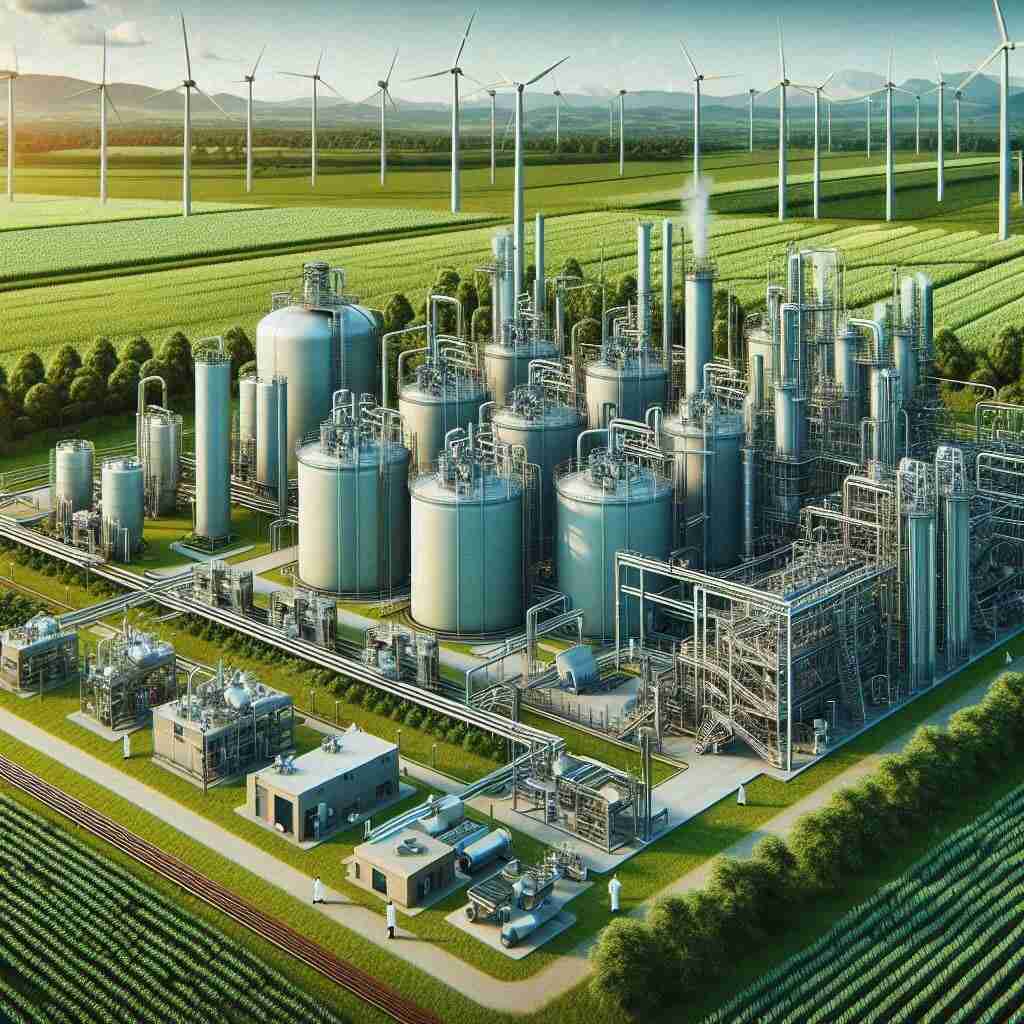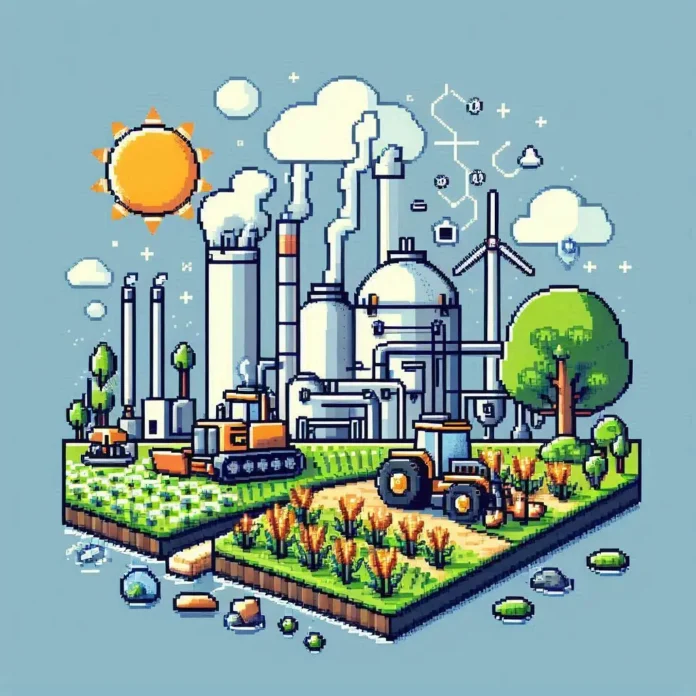Biomass conversion and biorefinery processes have become essential technologies, in order to fully utilize biomass’s potential for the production of energy, fuels, and chemicals. Interest in renewable energy sources has increased due to the world’s increasing energy consumption as well as the desire to combat climate change by reducing greenhouse gas emissions. Of these, biomass is the most adaptable and long-term choice.
Biomass conversion and biorefinery blog explores the relevance, workings, and potential to revolutionize sustainable energy in the future by delving into the complexities of biomass conversion and biorefinery.
Recognizing Biomass and Its Significance
The term “biomass” describes organic stuff that comes from microbes, plants, and animals. It comprises a diverse array of resources, including algae, specific energy crops, forestry waste, and agricultural wastes. Biomass is renewable and replenishable through natural processes, in contrast to fossil fuels. The potential of biomass to produce a carbon-neutral and sustainable energy source makes it significant. Biomass can help lower greenhouse gas emissions, improve energy security, and spur rural development if it is managed well.
The Biomass Conversion Concept
The process of converting raw biomass into useful products like biofuels, biochemicals, and bioenergy is known as biomass conversion. The three primary paths of the conversion process are thermal, chemical, and biological. Various pathways present different benefits and obstacles based on the biomass type and intended final products.
1. Thermal Conversion:
In this process, biomass is broken down into simpler chemicals using heat. These are the main techniques for thermal conversion:
- Combustion: The process of directly burning biomass to generate energy and heat. Even if it’s simple, strict emission regulations are necessary to reduce the impact on the environment.
- Pyrolysis is the process of heating biomass without oxygen to create char, syngas, and bio-oil. Pyrolysis provides versatility in the production of chemicals and liquid fuels.
- Gasification is the process of partially oxidizing biomass at high temperatures to produce syngas, which is a carbon monoxide and hydrogen combination. Chemicals and fuels can be made from syngas through further processing.
2. Chemical Conversion:
This process turns biomass into useful goods through chemical reactions. Important techniques consist of:
- Hydrolysis is the process of converting biomass into sugars that may be fermented into biofuels like ethanol by adding water and catalysts.
- Transesterification: Reaction with alcohol to produce biodiesel from vegetable or animal fats.
- Catalytic conversion is the process of turning intermediates produced from biomass into chemicals and fuels using catalysts.
3. Biological Conversion:
This process turns biomass into biofuels and biochemicals by utilizing microbes and enzymes. Key procedures consist of:
- Fermentation: To produce ethanol, butanol, and other biofuels, microorganisms need carbohydrates. Biochemicals such as succinic acid and lactic acid can also be produced through sophisticated fermentation processes.
- Anaerobic Digestion: In the absence of oxygen, microorganisms break down organic materials to produce biogas, which is a carbon dioxide and methane mixture. Biogas can be converted to biomethane or used for energy and heat.
The Role of Biorefineries

Biorefineries are integrated manufacturing facilities that generate a variety of bio-based products through the use of biomass conversion processes. The idea behind a biorefinery is similar to that of a petroleum refinery, which transforms crude oil into different kinds of chemicals and fuels. By co-producing a variety of products, biorefineries seek to maximize the value generated from biomass, hence improving sustainability and economic feasibility.
Types of Biorefineries
- The goal of Sugar Platform Biorefineries is to transform biomass into sugars so that they can be fermented to produce biofuels and biochemicals. Examples are ethanol factories that use sugarcane or corn as feedstock.
- Thermochemical biorefineries: Generate syngas, bio-oil, and other intermediates by using heat processes such as gasification and pyrolysis. Fuels, chemicals, and electricity can be produced by further processing these.
- Lignocellulosic Biorefineries: These facilities work to turn lignocellulosic biomass—such as wood and agricultural waste—into fermentable sugars and other products. Pretreatment, enzymatic hydrolysis, and fermentation processes are frequently combined in these biorefineries.
Benefits of Biorefineries
- Resource Efficiency: Biorefineries increase resource efficiency by reducing waste and making use of the whole biomass feedstock. Materials, chemicals, and animal feed are examples of co-products that can increase total profitability.
- Sustainability: When compared to processes that rely on fossil fuels, biorefineries have the potential to drastically cut greenhouse gas emissions. A circular economy is facilitated by the integration of waste streams and the utilization of renewable biomass feedstocks.
- Energy Security: By reducing reliance on fossil fuels and increasing energy security, biorefineries can diversify energy sources. Regional economic growth can also be fostered by biomass sourced locally.
Possibilities as well as Challenges in Biomass Conversion and Biorefinery
Biomass Conversion and Biorefineries have enormous potential, but in order to fully reap their rewards, a number of issues need to be resolved.
Possibilities in Biomass Conversion and Biorefinery
- Technological Innovation: Opportunities to increase biomass conversion efficiency and product yields are presented by developments in biotechnology, catalysis, and process engineering. Promising innovations include the creation of sophisticated catalysts and the genetic engineering of microbes.
- Integrated Systems: By combining biorefineries with current energy and industrial processes, it is possible to improve resource efficiency and financial sustainability. Utilizing existing infrastructure, biorefineries can be co-located with power plants or pulp and paper mills.
- Bio-based Economy: The transition to a bio-based economy offers chances to expand the markets for biofuels, biochemicals, and products derived from biomaterials. Industry cooperation can encourage the use of bio-based products.
- Sustainable Agriculture: Crop rotation and agroforestry are two sustainable agricultural techniques that can provide a consistent supply of biomass feedstocks. Encouraging the production of biomass and sustainable land use is essential to ensure long-term feedstock availability.
Challenges in Biomass Conversion and Biorefinery
- Feedstock Variability: The availability, moisture content, and composition of biomass feedstocks differ greatly. It is essential to design strong and adaptable conversion processes to accommodate a variety of feedstocks.
- Economic Viability: High startup and running costs may make biorefineries less profitable. Economies of scale and technological developments are essential for cost reduction and increased competitiveness.
- Technological Barriers: A lot of methods for converting biomass are still in the research and development or early commercialization phases. In order to improve efficiency and get beyond technical constraints, more research and innovation are required.
- Policy and Regulatory Support: To promote investment in and the installation of biorefineries, supportive policies and regulatory frameworks are crucial. Mechanisms for carbon pricing, subsidies, and incentives may be very important.
Success Stories and Case Studies of Biomass Conversion and Biorefinery
The promise of biomass conversion and biorefinery technology is demonstrated by a number of successful projects around the globe.
- Project Liberty – Poet-DSM (USA): Corn stover is transformed into ethanol at this commercial-scale cellulosic ethanol facility located in Iowa. The experiment demonstrates the practicality of lignocellulosic biorefineries as well as the possibility of producing biofuel on a big scale.
- Norway’s Borregaard Biorefinery is one of the most sophisticated biorefineries in the world, using wood to produce a variety of bio-based materials, chemicals, and energy. Their comprehensive strategy optimizes the value obtained from biomass.
- The Inbicon Biomass Refinery in Denmark is a demonstration plant that produces animal feed, biogas, and cellulosic ethanol from wheat straw. The project emphasizes how crucial it is to produce ethanol from agricultural leftovers.
- Clariant Sunliquid® Plant (Germany): Clariant’s flagship biorefinery turns agricultural leftovers into cellulosic ethanol by utilizing their patented Sunliquid® technology. The plant is a prime example of biomass conversion technology advancement.
The Future of Biomass Conversion and Biorefinery
Biomass Conversion and Biorefinery have a bright future because of the growing need for environmentally friendly energy sources and technological improvements. Important changes and trends to keep an eye on are:
- Advanced Biofuels: The development of advanced biofuels will be essential to lowering transportation’s carbon footprint and reducing reliance on fossil fuels. Examples of these fuels are drop-in fuels, cellulosic ethanol, and biobutanol.
- Biochemical Production: Consumer demand for sustainable products and regulatory pressure to cut back on plastic waste and carbon footprints will accelerate the transition towards bio-based chemicals and materials.
- Decentralized Biorefineries: Local energy generation and rural development can be fostered by small-scale, decentralized biorefineries. Biorefinery designs that are versatile and modular will allow for cost-effective deployment in a variety of settings.
- Digitalization and Automation: By combining digital technologies like automation, big data analytics, and artificial intelligence, biomass conversion processes will become more optimized and efficient.
- Circular Economy: Biorefineries that prioritize resource recovery, waste minimization, and sustainable production methods will be developed in accordance with the circular economy’s tenets.
In summary,
A revolutionary strategy for producing sustainable energy is represented by biomass conversion and biorefinery operations. These technologies can lower greenhouse gas emissions, improve energy security, and spur economic growth by utilizing biomass. Future biobased developments will be made possible by persistent innovation, encouraging legislation, and cooperative efforts, even in the face of ongoing obstacles. Biorefineries and biomass conversion will be essential in reshaping the energy landscape and tackling environmental issues as the world gets closer to a more sustainable future.
What are the main types of biomass used in biomass conversion and biorefineries?
The following are the primary biomass kinds utilized in biorefineries and biomass conversion:
Agricultural residues include maize stover, wheat straw, rice husks, and sugarcane bagasse—the remaining portions of crops that are not used for food or feed.
Branches, leaves, and other materials left over from logging operations and forest management activities are referred to as forestry residues.
Energy crops: These include willow, miscanthus, and switchgrass, which are cultivated expressly for their ability to produce energy.
Algae: Because of its high oil content and quick growth rates, algae can be grown and collected for the manufacture of biofuel.
Food trash, animal dung, and other organic materials that can be transformed into biochemicals and bioenergy are all considered organic waste.
Municipal Solid Waste (MSW): A number of MSW fractions, including organic materials, paper, and cardboard, can be processed to create biofuels and other goods.
These varied feedstocks help to the sustainability and financial sustainability of biorefineries by offering flexibility in biomass conversion processes.
What are the environmental benefits of biomass conversion and biorefineries?
There are various environmental advantages to biomass conversion and biorefineries:
Diminution of Greenhouse Gas Emissions: When biomass is utilized in place of fossil fuels, it can assist lower carbon dioxide emissions since it is a renewable resource. It is a carbon-neutral energy source because the carbon absorbed by plants during growth balances the carbon emitted during biomass conversion.
Waste Reduction: By converting organic waste, forestry waste, and agricultural residues into biomass, garbage is kept out of the landfill or burned, which lessens pollution to the environment.
Biodiversity and Soil Health: Using energy crops and sustainable farming methods can help to maintain biodiversity, stop erosion, and improve soil health. Leaves from crops that are not harvested can add organic matter to the soil.
Sustainable Land Use: By growing energy crops on marginal lands unsuitable for food production, food crops can be avoided and more sustainable land use techniques can be implemented.
Circular Economy: Biorefineries close the loop on resource consumption and reduce waste by turning waste materials into useful goods. This is how they support a circular economy.
These advantages highlight how biomass conversion and biorefineries contribute to environmental sustainability and the fight against climate change.


[…] environment and the economy over conventional fossil fuels. This blog explores the complexities of biomass briquettes and pellets, including their environmental friendliness, the raw materials needed, the manufacturing process, […]